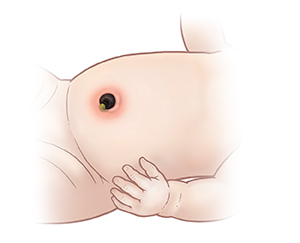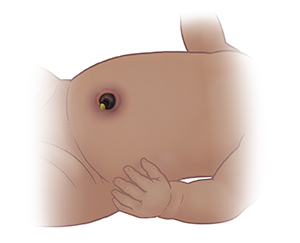Umbilical Cord Care (Newborn)
The umbilical cord is the tube that connects the baby to the mother. In the uterus, the umbilical cord carries blood, oxygen, and nutrition to the baby. At birth, the umbilical cord is clamped and cut. This leaves a small stump. The clamp prevents blood flowing out of the baby through the cord.
In most cases, the umbilical cord stump dries up and falls off the newborn in the first few weeks of life.
Home care
The following will help you care for your baby’s umbilical cord at home:
-
Keep the cord clean and dry.
-
Keep the cord exposed to air. Don’t cover it up inside the diaper where it may come in contact with urine or stool. To prevent this, fold the front of the diaper down below the cord. If needed, cut a notch in the front of the diaper to make a space for the cord.
-
Don’t dress your baby in clothing that is tight across the cord.
-
Don’t put your baby in bathwater until the cord has fallen off and the area where the cord was attached is dry and healing. Instead, bathe your baby with a sponge or damp washcloth.
-
Don’t try to remove the cord. It will fall off on its own.
-
Don’t use rubbing alcohol, or talc or other powders on the cord.
Follow-up care
Follow up with your baby’s health care provider as advised.
When to get medical advice
Contact your baby’s health care provider right away if any of these occur:
-
The skin around the base of the cord is red or bleeding.
-
There is a bad smell, pus, or other discharge from the cord.
-
Your baby has a fever (see “Fever and children” below)
-
Your baby cries when you touch the cord or the area around it.
 |
| Umbilical cord inflammation on light skin. |
 |
| Umbilical cord inflammation on dark skin. |
Fever and children
Use a digital thermometer to check your child’s temperature. Don’t use a mercury thermometer. There are different kinds and uses of digital thermometers. They include:
-
Rectal. For children younger than 3 years, a rectal temperature is the most accurate.
-
Forehead (temporal). This works for children age 3 months and older. If a child under 3 months old has signs of illness, this can be used for a first pass. The health care provider may want to confirm with a rectal temperature.
-
Ear (tympanic). Ear temperatures are accurate after 6 months of age, but not before.
-
Armpit (axillary). This is the least reliable but may be used for a first pass to check a child of any age with signs of illness. The provider may want to confirm with a rectal temperature.
-
Mouth (oral). Don’t use a thermometer in your child’s mouth until they are at least 4 years old.
Use the rectal thermometer with care. Follow the product maker’s directions for correct use. Insert it gently. Label it and make sure it’s not used in the mouth. It may pass on germs from the stool. If you don’t feel okay using a rectal thermometer, ask the provider what type to use instead. When you talk with any provider about your child’s fever, tell them which type you used.
Below are guidelines to know if your young child has a fever. Your child’s provider may give you different numbers for your child. Follow the provider’s specific instructions.
Fever readings for a baby under 3 months old:
Online Medical Reviewer:
Daphne Pierce-Smith RN MSN
Online Medical Reviewer:
Sravani Chintapalli Researcher
Online Medical Reviewer:
Tracy C. Garrett RNC-NIC BSN
Date Last Reviewed:
2/1/2025
© 2000-2025 The StayWell Company, LLC. All rights reserved. This information is not intended as a substitute for professional medical care. Always follow your healthcare professional's instructions.